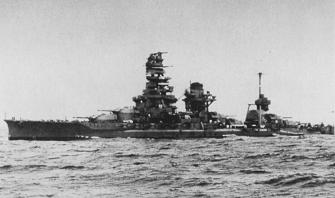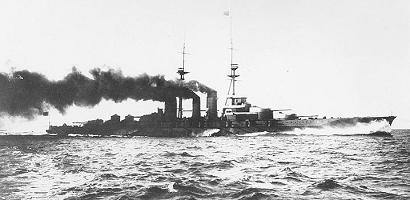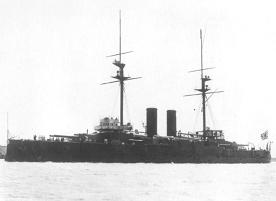DREADNOUGHTS
August
1914 Strength (2)
1.
SETTSU class, KAWACHI, SETTSU, 2 ships, 1
lost - 21,400t, 20 knots, 4-30.5cm/50 and
8-30.5cm/45
(different barrel lengths)/10-15.2cm/8-12cm, 990
crew,
1912

HIJMS
Settsu (Photo Ships)
KAWACHI (ancient
province), 12th July
1918, Japan,
Tokuyama Bay, southern Honshu in Inland Sea (c
34-00’N,
131-45’E) - magazine explosion. 'Kawachi' sank
in 4 minutes
with the loss of over 500 men killed; 25
officers and
312 ratings were saved. She was later broken up
Wartime
Additions (4)
2. FUSO
class, FUSO, YAMASHIRO (both lost in World
War 2) - 30,600t, 22 knots, 12-35.6cm/16-15.2cm,
1,190
crew, 1915/1917
3. ISE
class, HYUGA, ISE (below) (both lost
in World War 2)
- 31,300t, 23 knots, 12-35.6cm/20-14cm, 1,360
crew,
1917/1918

HIJMS
Ise after later rebuild
(Maritime Quest)
BATTLECRUISERS
August
1914 Strength (1)
4.
KONGO class, KONGO, 1 of 4 ships completed
before
start of war (lost in World War 2) - 27,500t, 27
knots,
8-35.6cm/15-15.2cm, 1,220 crew, 1913
Wartime
Additions (3)
4.
KONGO class completed 1914-15, HARUNA, HIEI,
KIRISHIMA
(all
lost in World War 2)
Haruna,
according to two sources, was
damaged in the South Pacific on a mine laid by
German
raider 'Wolf'. Mines were laid by the raider in
mid-1917 off New Zealand, the east coast of
Australia, and Singapore, but this incident
needs
confirmation

HIJMS
Haruna (Maritime Quest)
2nd
Class BATTLECRUISERS
August
1914 Strength (4)
5.
TSUKUBA class, IKOMA, TSUKUBA, 2 ships, 1
lost - 13,700t, 20 knots,
4-30.5cm/12-15.2cm/12-12cm, 880
crew, 1907/08
Tsukuba,
battlecruiser 'Kurama' and armoured cruiser
'Asama'
of First South Sea Squadron searched the
Carolines,
Marshalls and Western Pacific north of the
equator
for Adm von Spee’s Fleet, September - November
1914. After the Anglo-German Battle of Coronel,
she
prepared to move to the South Central Pacific
where
sister ship 'Ikoma' was to join the Squadron
TSUKUBA (ancient
province in Tokyo
area), 14th January 1917, Japan off Yokosuka in
Tokyo Bay (c 35-00’N, 139-30’E)
- magazine
explosion. The
fore magazine exploded killing 200 men and
setting
'Tsukuba' on fire as she was at anchor in the
Bay.
She sank 20 minutes later in shallow waters
close
inshore with masts, bridge and funnels above
water,
the explosion due to propellant decomposition.
Fortunately half of the crew was on shore leave,
but
casualties still included 305 men lost.
'Tsukuba' was
later raised and broken up.
6.
IBUKI class, IBUKI, KURAMA, 2 ships -
14,600t,
20.5 knots, 4-30.3cm/8-20.3cm/14-12cm, 840 crew,
1909/11
Ibuki joined
the hunt for 'Emden' in the East Indies in
September
1914, in October took part in the escort of New
Zealand troops to Australia, and early next
month,
because of the shortage of British ships helped
escort the combined ANZAC convoy across the
Indian
Ocean. After 'Sydney' had been detached and sank
'Emden', the 'Ibuki' was for a while the only
protection for the ANZACs. She later joined the
Second South Sea Squadron in the SW Pacific to
hunt
for von Spee
Kurama,
battlecruiser 'Tsukuba' and armoured cruiser
'Asama'
of First South Sea Squadron searched the
Carolines,
Marshalls and Western Pacific north of the
equator
for Adm von Spee’s Fleet, September - November
1914, and after the Battle of Coronel, prepared
to
move to the South Central Pacific
PRE-DREADNOUGHT
BATTLESHIPS
August
1914 Strength (10)
7.
KASHIMA class, KASHIMA, KATORI, 2 ships
-
16,400t, 18 knots, 4-30.5cm/4-25.4cm/12-15.2cm,
860 crew,
1906

HIJMS
Katori (Maritime Quest)
8.
SATSUMA class, AKI, SATSUMA, 2 ships -
19,400t, 18 knots, 4-30.5cm/12-25.4cm/12-12cm, 900
crew,
1910/1911

HIJMS Aki
(Maritime Quest)
Satsuma with
light cruisers 'Hirado' and 'Yahagi' sailed as
the
Second South Sea Squadron to search the
Philippines,
Palau Islands and East Indies area,
October-November
1914 in the von Spee hunt, and after Coronel
moved
towards the South Central Pacific.
9.
Russo-Japanese 1904-05 War prizes, HIZEN, IKI,
IWAMI, SAGAMI, SUWO,
TANGO, 5 ships
Sagami (13,500t,
4-25.4cm)
returned as 'Perseviet' to Russia in 1916
Hizen
(12,700t,
30.5cm guns) joined armoured cruiser 'Idzumo' in
1914
in North American waters on trade protection,
and
after the Battle of Coronel moved down the the
west
coast of the Americas in the hunt for von Spee.
Tango
(11,000t)
returned as 'Poltava' to Russia in 1916
COAST
DEFENCE SHIPS (ex-battleships)
August
1914 Strength (4)
10.
FUJI (mount Fuji-Yama) - 12, 500t, 18 knots,
4-30.5cm/10-15.2cm, 640 crew, 1897
11.
SHIKISHIMA class, ASAHI (morning or rising
sun), SHIKISHIMA (old poetic name for
Japan),
2 ships - 15,200t, 18 knots, 4-30.5cm/14-15.2cm,
840
crew, 1900
12.
MIKASA (mountain) - 15,100t, 18
knots,
4-30.5cm/14-15.2cm, 830 crew, 1902.
Mikasa, a
pre-dreadnought, is still in existence as museum
ship
at Yokosuka, south of Tokyo

HIJMS
Mikasa (Maritime Quest)
ARMOURED
CRUISERS
August
1914 Strength (8)
The four 2nd class battlecruisers of the 'Ibuki'
and
'Tsukuba' classes (above) are sometimes
classified as
armoured cruisers to give a total of 12
13.
ASAMA class, ASAMA (sacred volcanic
island), TOKIWA (evergreen), 2
ships -
9,700t, 21 knots, 4-20.3cm/14-15.2cm, 730 crew,
1899
Asama, with
battlecruisers 'Kurama' and 'Tsukuba' of First
South
Sea Squadron searched the Carolines, Marshalls
and
Western Pacific north of the equator for Adm von
Spee’s Fleet, September - November 1914, and
after the Battle of Coronel, prepared to move to
Chilean waters
Tokiwa and
armoured cruiser 'Yakumo' were at Singapore when
'Emden' was sunk in early November 1914,
preparing to
form a Japanese squadron to work in the Bay of
Bengal
14.
IDZUMO class, IDZUMO, IWATE, 2 ships -
9,700t, 20 knots, 4-20.3cm/14-15.2cm, 670 crew,
1900-01
Idzumo moved
from Mexican to North American waters after the
declaration of war to protect Allied trade,
later
heading for South American waters to play her
part in
the hunt for von Spee. In August 1917 she
arrived in
the Mediterranean to relieve protected cruiser
'Akashi' as flagship of the destroyer flotillas
based
at Malta on convoy protection duties
Iwate joined
First South Sea Squadron in the South Central
Pacific
to hunt for von Spee
15.
YAKUMO - 9,600t, 20 knots,
4-20.3cm/12-15.2cm, 700
crew, 1900
Yakumo and
armoured cruiser 'Tokiwa' were at Singapore when
'Emden' was sunk, preparing to form a Japanese
squadron to work in the Bay of Bengal
16.
ADZUMA - 9,300t, 20 knots,
4-20.3cm/12-15.2cm, 650
crew, 1900
17.
KASUGA class, KASUGA, NIISHIN, 2 ships -
both 7,600t, 20 knots, 600 crew, 1904; 'Kasuga' -
1-25.4cm/2-20.3cm/14-15.2cm, 'Niishin' -
4-20.3cm/14-15.2cm
Nisshin prepared
to
join the Second South Sea Squadron based at Truk
in the search for von Spee
PROTECTED
CRUISERS
August
1914 Strength (15)
18.
TAKACHIHO - 3,600t, 18 knots, 6 or 8-15cm,
325 crew,
1886
Takachiho was
part of the large Japanese fleet engaged in the
capture of the German base of Tsingtau in
northern
China. Directly engaged in the attack were three
old
battleships, two coast defence ships, three
armoured
cruisers, a seaplane carrier and destroyer
flotilla
with its light cruiser leader. Patrolling the
Yellow
Sea was a dreadnought, two battleships, four
light
cruisers and a destroyer flotilla, and further
south
still another light cruiser and six gunboats
TAKACHIHO (also
'Takaschio', sacred place
in Japan), 17th October 1914, NE China, off
Tsingtau in the Yellow Sea (c 36-00’N, 120-30’E)
- torpedoed by German torpedo boat 'S-90'.
Employed as a minelayer, the
'Takachiho' was attacked by the 'S-90' which
managed
to slip out of Kiaochow (Kiao Chau) Bay on the
night
of the 17th/18th as the siege approached its
end; 271
men were lost as she went down. Some sources
locate
her loss in Kiaochow Bay, others further
offshore in
the Yellow Sea. 'S-90' was run aground SE of
Tsingtao
later the same day and scuttled. (One source
describes 'Takachiho' as on patrol when she was
mined
on the 19th with the loss of 243 men.)
19.
MATSUSHIMA class, HASHIDATE (port), ITSUKUSHIMA,
2 ships - 4,200t, 16 knots, 1-32cm/12-12cm, 360
crew,
1894/91.
Training ships from
1906
20.
AKITSUSHIMA - 3,100t, 19 knots,
4-15.2cm/6-12cm, 330
crew, 1894
21.
SUMA class, AKASHI (place in Japan),
SUMA (place in Japan), 2 ships - 2,700t, 19
knots,
2-15.2cm/6-12cm, 310 crew, 1899/96
Akashi arrived
in Malta in mid-April 1917 as flagship of eight
destroyers of 10th and 11th Flotillas, sent at
British request for convoy protection in the
Mediterranean. She was relieved by armoured
cruiser
'Idzumo' in August
22.
CHITOSE class, KASAGI, CHITOSE (long life),
2 ships, 1 lost - 4,800t, 22 knots,
2-20.3cm/10-12cm, c
430 crew, 1898/99
KASAGI
(mountain), 13th August 1916, Japan in Tsugaru
Strait separating northern Honshu from Hokkaido
- wrecked. Serving as a training ship
23.
TSUSHIMA class, NIITAKA, TSUSHIMA (strait),
2 ships - 3,400t, 20 knots, 6-15.2cm, 320 crew,
1904
24.
OTOWA - 3,000t, 21 knots, 2-15.2cm/6-12cm,
310
crew, 1904
OTOWA
(mountain or river?), 1st
August 1917, Japan,
near Cape Daio or Taio, southern Honshu in
Pacific Ocean (c
34-50’N, 137-00E) - ran aground and wrecked.
Presumed serving as protected
cruiser
25.
Russo-Japanese 1904-05 War prizes, ASO, SOYA,
TSUGARU
('Suzuya'
stricken 1913)
Soya (6,500t)
returned as 'Varyag' to Russia in 1916, but ran
aground, salved and taken over by British
LIGHT
CRUISERS
August
1914 Strength (6)
26.
TONE - 4,100t, 23 knots, 2-15.2cm/10-12cm,
370
crew, 1910
27.
YODO class, MOGAMI, YODO, 2 ships - 1,250t,
22
knots, 2-12cm/4-7.8cm, 180 crew, 1908.
Reclassified as
gunboats
28.
CHIKUMA class, CHIKUMA, HIRADO, YAHAGI, 3
ships - 5,000t, 26 knots, 8-15.2cm/4-7.8cm, 415
crew,
1912
Chikuma joined
the hunt for 'Emden' in the East Indies and
Indian
Ocean in September, and later prepared to move
to the
Pacific in the hunt for von Spee
Yahagi first
joined the hunt for the 'Emden' in the Indian
Ocean.
Then Hirado and Yahagi with
battleship
'Satsuma' sailed as the Second South Sea
Squadron to
search the Philippines, Palau Islands and East
Indies
area, October-November in the von Spee hunt, and
after Coronel moved towards the South Central
Pacific.
SEAPLANE
CARRIER
August
1914 Strength (1)
29.
WAKAMIYA - 5,900t, 10 knots, 4 Farman
seaplanes, 230
crew, converted 1914 from naval transport
Wakamiya and
her aircraft took part in the siege of Tsingtao.
According to Conway, the Farmans reportedly sank
one
German minelayer and damaged shore
installations. If
so this would be the first successful carrier
air
raid in history, but needs confirmation
DESTROYERS
August
1914 Strength (50)
30.
IKAZUCHI class, AKEBONO (dawn
or daybreak), OBORO (haziness at
moonlight), 2
ships - 360t, 31 knots, 1-12pdr/5-6pdr/2-45.7cm
tt, 55
crew, 1899/00
Class nameship
'Ikazuchi' sank in 1913
31.
MURAKUMO class, KAGERO (shimmering mist or
gossamer), MURAKUMO (cloud cluster),
SHIRANUI (or
'Siranui', phosphorescent foam), USUGUMO (fleecy
clouds), YUGIRI (evening mist), 5 ships -
275t, 30
knots, 1-12pdr/5-6pdr/2-45.7cm tt, 54 crew,
1898/00
32.
KASUMI (mist of flowers) - 360t, 31 knots,
2-12pdr/4-6pdr/2-45.7cm tt, 59 crew, 1902
33.
SHIRAKUMO class, ASASHIO (or 'Asasio',
morning tide), SHIRAKUMO (or 'Sirakumo',
white
clouds), 2 ships - 340t, 31 knots,
2-12pdr/4-6pdr/2-45.7cm tt, 59 crew, 1901/02
34.
HARUSAME class, ARARE (hail), ARIAKE
(dawn with the moon present), ASAGIRI (morning
mist), FUBUKI (or 'Hubuki', blizzard),
MURASAME
(scattered showers), 5 ships - 375t, 29 knots,
2-12pdr/5-6pdr/2-45.7cm tt, 55 crew, 1903-05
Class nameship
'Harusame' sank in 1911
35.
ASAKAZE class, ASAKAZE (morning breeze),
SHIROTAYE and others, 31 ships in total, 1
lost -
380t, 29 knots, 6-7.8cm/2-45.7cm tt, 70 crew,
1905-09
SHIROTAYE (or
'Shirotae', white in
poetical language), 3rd September 1914, NE
China, off Tsingtau in the Yellow Sea (c
36-00’N, 120-30’E)
- wrecked.
Taking part in
operations against besieged fortress of
Tsingtau;
reportedly in action with German gunboat
"Jaguar" at the time she was wrecked. Some
sources locate her loss in Kiaochow (Kiao Chau)
Bay,
others further offshore in the Yellow Sea
36.
UMIKAZE class, UMIKAZE (sea breeze), YAMAKAZE
(wind from the hills), 2 ships - 1,030t, 33
knots,
2-12cm/5-7.8cm/4-45.7cm tt, 140 crew, 1911
37.
SAKURA class, SAKURA (cherry),
TACHIBANA, 2 ships - 605t, 30 knots,
1-12cm/4-7.8cm/4-45.7cm tt, 92 crew, 1912
Wartime
Additions (c 27)
38.
KABA class, KABA (birch), KAEDE,
KASHIWA,
KATSURA, KIRI, KUSUNOKI, MATSU, SAKAKI, SUGI,
UME, 10
ships - 665t, 30 knots, 1-12cm/4-7.8cm/4-45.7cm
tt, 92
crew, 1915
Eight of the 'Kaba'
class, including 'Sakaki' arrived at Malta in
mid-April 1917 for convoy protection duty as the
10th
and 11th Flotillas with cruiser 'Akashi' as
their
flagship
Sakaki,
damaged 11th June 1917, Eastern
Mediterranean off Crete - torpedoed once by
Austrian
'U.27'. On escort
duty, her bows were blown off when many of the
crew
were forward in the mess hall; 68 men killed.
She was
salvaged and repaired
39.
MOMO class, HINOKI, KASHI, MOMO, YANAGI, 4
ships
- 835t, 31 knots, 3-12cm/6-45.7cm tt, 110 crew,
1916-17
The four 'Momo’s'
arrived in Malta in August 1917 as the 15th
Flotilla
with cruiser 'Idzumo' to add to the Japanese
contribution to convoy protection in the
Mediterranean
40.
ISOKAZE class, AMATSUKAZE (heavenly wind),
HAMAKAZE, ISOKAZE (shore breeze),
TOKITSUKAZE (or 'Tokitukaze', fair
wind), 4 ships - 1,230t, 31
knots, 4-12cm/6-45.7cm tt, 130 crew, 1917
41.
British ACORN class, SENDAN, KANRAN, 2 ships
-
770t, 27 knots, 2-10.2cm/2-53.3cm tt, 72 crew,
1912
'Minstrel' and
'Nemesis' handed over to Japanese Navy in June
1917
and manned by them for duration of the war in
the
Mediterranean. Renamed 'Sendan' and 'Kanran', to
bring the Japanese total in the Mediterranean to
14
destroyers. Returned at end of war
42.
ENOKI class, ENOKI, KEYAKI, KUWA, MAKI, NARA,
TSUBAKI , 6 ships - 850t, 31 knots,
3-12cm/6-45.7cm
tt, 110 crew, 1918
43.
URAKAZE - 910t, 30 knots,
1-12cm/4-7.8cm/4-53.3cm
tt, 120 crew, 1915
British built; not
delivered until 1919
SUBMARINES
August
1914 Strength (12)
44.
HOLLAND type, Nos 1-5, 5 boats - 100/125t,
8/7 knots, 1-45.7cm tt, 13 crew, 1905
No.4, 14th
November 1916, Japan, at Kure, southern Honshu
in Inland Sea (c 34-30’N,
133-00’E) - petrol explosion. Petrol-engined
submarine, later
raised and repaired; 2 men dead, 14 survivors
45.
KAIGUN HOLLAND type, No 7 - 57/63t, 8/4
knots,
1-45.7cm tt, 14 crew, 1906 (No 6 lost in 1910)
46. C1
- C2 VICKERS class, Nos 8-12, 5 boats -
290/320t, 12/4 knots, 2-45.7cm tt, 25 crew,
1909/11
47. VK
type, No 13 - 305/340t, 11/8 knots,
2-45.7cm tt, 26 crew, 1912
Wartime
Additions (3)
48. C3
VICKERS class, Nos 16-17, 2 boats -
290/320t, 12/4 knots, 2-45.7cm tt, 26 crew,
1916/17
49. S1
class, No 15 - 420/665t, 17/10 knots,
4-45.7cm tt/1-2pdr, c 30 crew, 1917.
French built; No 14
was commissioned as the French 'Armide'